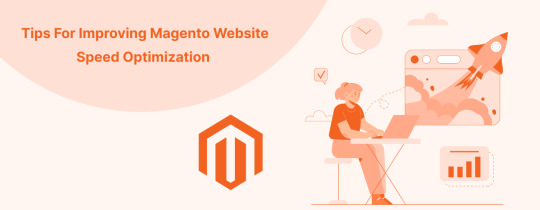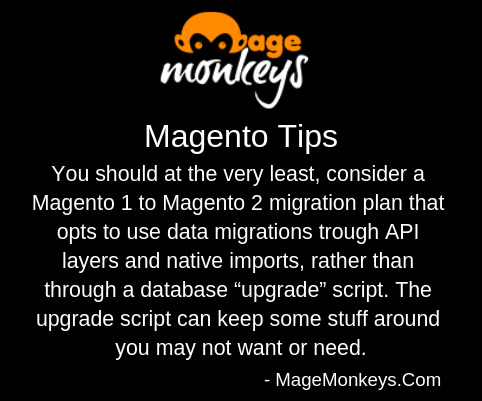#MagentoTips
Explore tagged Tumblr posts
Text

🚀 Elevate your Magento store with these must-have extensions!
#Magento#Ecommerce#SEO#PaymentGateway#Security#MagentoExtensions#OnlineStore#DigitalMarketing#MagentoTips#🔗 Visit www.exinent.com for more information!
0 notes
Text
5 FREE Developer Tools Every Magento 2 Programmer MUST Have
Here are 5 FREE Developer Tools Every Magento 2 Programmer MUST Have:
n98-magerun2 n98-magerun2 is a command-line utility that provides a wide range of features for managing and developing Magento stores. It can be used to perform tasks such as installing and updating modules, managing database tables, and generating reports.
QuickDevBar QuickDevBar is a Magento extension that adds a toolbar to the top of the admin panel. The toolbar provides a number of useful tools, such as a code editor, a database query tool, and a cache cleaner.
DisableTwoFactorAuth DisableTwoFactorAuth is a Magento module that allows you to temporarily disable two-factor authentication for a user. This can be useful if you need to troubleshoot a problem or if you need to access the admin panel without having to enter your two-factor authentication code.
dev:di:info dev:di:info is a Magento command that allows you to view the dependency injection configuration for a class. This can be useful for debugging problems with your code.
cache-clean cache-clean is a Magento command that allows you to clear the Magento cache. This can be useful if you are making changes to your code or if you are troubleshooting a problem.
These are just a few of the many free developer tools that are available for Magento 2. With these tools, you can improve your development workflow and make your job easier.
I would also add that it is important to choose a good code editor or IDE for Magento development. Some popular options include PhpStorm, Eclipse, and Visual Studio Code. These editors provide features such as syntax highlighting, code completion, and debugging tools, which can make your development workflow much more efficient.
youtube
#Magento#Magento2#DeveloperTools#FreeTools#WebDevelopment#Programming#PHP#ECommerce#MagentoTips#MagentoTricks#MagentoPerformance#MagentoSecurity#MagentoDebugging#MagentoDevelopment#Youtube
0 notes
Text
Tips for Magento Website Speed Optimization
Looking to improve the speed and performance 🚀of your Magento website? Check out our blog for expert tips on Magento website speed optimization. Read now and implement these tips for speed and performance!

#Magento#WebsiteSpeed#Optimization#eCommerce#WebsitePerformance#PageSpeed#MagentoTips#ImageOptimization#WebPerformance
1 note
·
View note
Video
youtube
The Power of Multi-Store Setups for Global eCommerce Growth
🌐 Expand Your eCommerce Empire with Multi-Store Setups!
In today’s global marketplace, a one-size-fits-all approach doesn’t cut it. Learn how multi-store setups empower businesses to: 🌎 Reach diverse international markets 🛒 Personalize shopping experiences 📈 Scale efficiently without complications
This video will break down: ✨ Why multi-store setups are essential for global eCommerce growth ✨ How to leverage Magento’s cutting-edge tools ✨ Tips for simplifying store management while boosting ROI
If you're ready to create localized storefronts, increase sales, and dominate the global market, this is the guide you’ve been waiting for!
📖 Dive deeper with the full article here: https://shorturl.at/PQmFZ
💬 Got questions or insights? Share them in the comments! 👍 Like and subscribe for more eCommerce growth strategies!
#globalecommerce #multistoresetup #magentotips #businessgrowth #magentobrain
0 notes
Text
5 tips to use e-commerce optimization for fashion e-commerce
It is a known fact that e-commerce optimisation services can offer e-commerce businesses marvellous results. How does e-commerce optimization work for fashion e-commerce? To put it into perspective, the fashion ecommerce industry is one of the fastest-growing online industries with the global fashion ecommerce market value being $821 billion.
That being said, this industry is very competitive. Thus, you should ensure that your e-commerce website Is equipped to handle the needs of customers and offer them something out of the ordinary but relevant.
5 ways in which e-commerce optimization helps your fashion e-commerce website:
Ecommerce optimization services are particularly specific for fashion brands. Let’s explore these five ways where fashion websites can benefit from ecommerce optimization.
Innovative Presentation of Products
To combat your customer’s fear of not being able to feel the texture of your fabrics you should incorporate real-life experiences as closely as you can.
How so? You can make use of Innovative visualisation methods such as 360-degree product images, a catwalk to show customers how clothing might look like walking, and a zoom-in option for customers to see the texture of the fabrics, along with fine cuts, pockets and patterns.
2. Presence of Care and Handling Sections
Customers appreciate when fashion e-commerce websites put information regarding the care of fabrics on their websites. This allows customers to retain the quality of their favourite clothing from your website for a prolonged period.
You can choose to add information such as how to clean it, how to iron it or store it, or if it's waterproof.
3. Information regarding fit and features
Not all clothing types suit every person out there and e-commerce websites should try to convey how their clothing might look to people with different build and heights. You can choose to put the model's height on the product information pages so that customers can compare their height to the models to visualise how a dress might look.
Make sure to add sufficient information regarding the clothing be it model height, sleeve length, garment length, pockets and collars and the features of the fabrics.
4. Use of product stories
Making use of storytelling to convey a story around the product is one of the best strategies that e-commerce websites can use to keep the attention of their customers.
Human beings are fundamentally storytelling beings. Thus, you can tell your customers about the idea behind clothing or how the fabric used to make the clothing was sourced.
5. Easy availability of size guides
When it comes to online shopping the most common problem that customers face is size issues. Thus, you should consider displaying as much information as you can regarding the sizes of your clothing. Additionally, you can also present all forms of sizes used around the globe be it UK size, US size or Europe. This way your customers would easily be able to choose the right clothing hassle-free.
In case you require more assistance with your optimization efforts you can choose to seek help from reputed ecommerce optimization services agencies.
You may also like to read:
Conversion Rate Optimization for Your eCommerce Business
Optimize Your CRO Strategy on MagentoTips for Conversion Rate Optimization in Magento
0 notes
Link
Howdy, Magento Folks!
In a mini cart, users resume shopping effortlessly from the mini cart. And after they complete adding or removing the products, they can move forward to the checkout page. Still, sometimes a store owner would want to remove the mini cart functionality from their Magento 2 store. Have a look at How to Hide or Remove Mini cart in Magento 2.
Complete Guide at How to Hide or Remove Minicart in Magento 2
0 notes
Link
0 notes
Photo

#magento #magentotip #magentodevelopment #magemonkeys
1 note
·
View note
Text

Master Your Inventory with Magento! 📦✨
#Magento#InventoryManagement#EcommerceTips#StockControl#MagentoTips#BusinessGrowth#OrderManagement#Exinent#www.exinent.com
0 notes
Text
What are some good and elegant Magento themes for an e-commerce site?
Porto:
One of the top-selling Magento themes on ThemeForest. It's fully responsive, easy to customize, and suitable for any type of online store.
Ultimo:
A premium theme known for its flexibility and customizable design. It offers a fluid product grid and unlimited layout options.
Fastest:
As the name suggests, it's optimized for speed. It also provides a sleek design suitable for a variety of e-commerce niches.
Claue:
A minimalist theme that's focused on products. It comes with a variety of homepage layouts and is perfect for modern online stores.
MegaShop:
A fully responsive theme suitable for any e-commerce niche. It's bundled with premium features and offers multiple layouts.
Market:
A multipurpose theme offering integrated extensions, mobile optimization, and vertical mega menus.
Ves Fasony:
A theme tailored for fashion stores, it offers a clean, modern design with a focus on large images and easy navigation.
Ves Flashshop:
A multi-purpose theme known for its impressive visual content and advanced features suitable for any store type.
Sahara:
A versatile theme with a range of layouts suitable for fashion, digital, and even furniture stores.
Supro:
A minimal Magento 2 theme for fashion, optimized for performance and offering a range of pre-built layouts.
Fortis:
Fully responsive with unlimited color options. It's user-friendly and suitable for any product range.
Ves Evolution:
A theme suitable for tech and electronics stores, offering a modern and sleek design.
Athlete2:
Tailored for sports-related e-commerce sites, this theme offers a bold design and integrates with various extensions.
Ketty Magento 2:
A fashion-centered theme that's fully responsive and offers a sophisticated design.
Ves Pencil:
Ideal for fashion designers or furniture creators, this theme offers a minimalist, image-focused design.
When choosing a Magento theme, ensure that it aligns with the goals and aesthetics of your brand. Look out for themes that are regularly updated, compatible with the latest version of Magento, and are backed by strong customer support. Also, consider the ease of customization and integrated features that can save you time and money in the long run.
#MagentoThemes#EcommerceDesign#MagentoEcommerce#WebDesignTrends#ResponsiveDesign#Ecommerce2023#OnlineStoreDesign#MagentoTips#BestMagentoThemes#EcommerceSuccess#DigitalStorefront#MagentoCustomization#EcommerceEvolution#WebStoreAesthetics#UpgradeYourEstore#vinhjacker#mageplaza
0 notes
Link
0 notes
Link
0 notes
Link
You have a great eCommerce store. You think everything’s in place. There are lots of visitors but, strangely, too few purchases. You’re not alone. Perhaps cart abandonment is the scariest nightmare that shocks eCommerce stores to near death. Shopping cart abandonment, the site visitors action of adding items to the virtual shopping cart but quitting …
#magentostore#magentotips#magento#eCommercestore#Shoppingcart#userexperience abandonmentrates#userexperience#abandonmentrates
0 notes
Text
RT @roma_glushko: Did you know #Magento2 can generate DTO mappers for you? #magentocommunity #magedevs #magento #magentotips https://t.co/zHYNQVqAMf
Did you know #Magento2 can generate DTO mappers for you? #magentocommunity #magedevs #magento #magentotips pic.twitter.com/zHYNQVqAMf
— Roman Glushko - #MageNews April 🆕 (@roma_glushko) April 2, 2019
from Twitter https://twitter.com/fbeardev
0 notes
Text
RT @plugincompany1: Stop relying on third parties for #FraudPrevention and take matters into your own hands! Read more ➡ https://t.co/WXSVFVXdu1 #MagentoTips #Magento2 #MagentoExtensions https://t.co/a1Nqx7oRBe
Stop relying on third parties for #FraudPrevention and take matters into your own hands! Read more ➡ https://t.co/WXSVFVXdu1#MagentoTips #Magento2 #MagentoExtensions pic.twitter.com/a1Nqx7oRBe
— Plugin Company (@plugincompany1) February 5, 2018
from Twitter https://twitter.com/fbeardev
0 notes
Text
RT @GuarinoMagento: #MagentoTip of the Day⚡️ Get the access token to work w/ the Magento 2 API from the admin: System → Extensions → I… https://t.co/ImPvW9NH6H
#MagentoTip of the Day⚡️ Get the access token to work w/ the Magento 2 API from the admin: System → Extensions → Integration#realmagento pic.twitter.com/H63sKay9Ch
— Gabriel Guarino (@GuarinoMagento) February 13, 2017
from Twitter https://twitter.com/fbeardev
0 notes